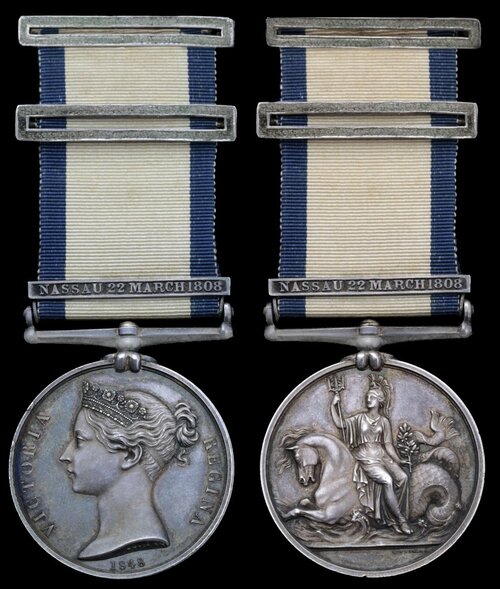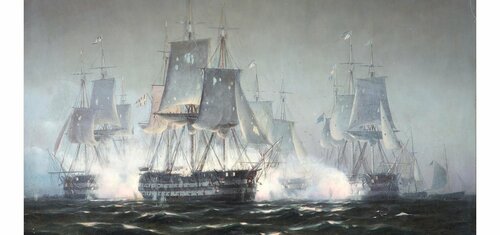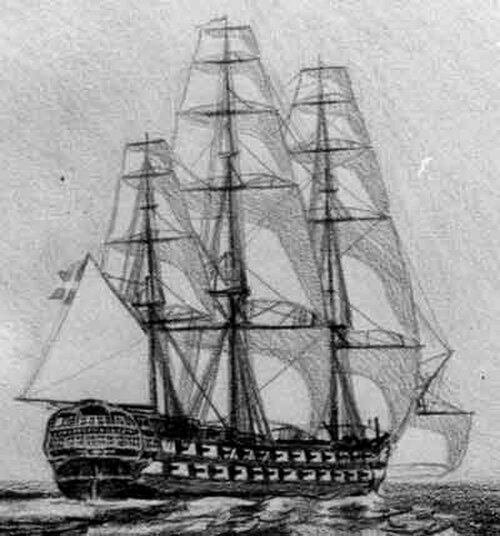Auction: 22001 - Orders, Decorations and Medals
Lot: 2
(x) The fascinating Naval General Service Medal awarded to Midshipman Edward John Johnson R.N., who was wounded in action during the Battle of Zealand Point in March 1808, went on to serve aboard the flagship of the North American station during the Chesapeake Campaign, and concluded his career as superintendent of the Royal Navy's Compass Department during the age of the famous polar explorers Sir John Franklin and Sir James Clark Ross - the latter named Cape Johnson in Antarctica in his honour
Naval General Service 1793-1840, 1 clasp, Nassau 22 March 1808 (E. J. Johnson, Midshipman.), on original riband mounted with two silver buckles, housed in a red leather case perhaps originally containing a compass, extremely fine
Edward John Johnson, son of the Reverend Henry Johnson of Bywell, Northumberland, was born in 1795 and joined the Royal Navy on 1 May 1807 as a First-Class Volunteer. Assigned to the 60-gun H.M.S. Nassau, he quickly found himself in action at the Battle of Zealand Point (Medal and Clasp), notable for the destruction of the 74-gun Prins Christian Frederik, the last Danish ship of the line of the Napoleonic Wars.
The Battle of Zealand Point saw a British squadron (led by the Nassau) pursue and overwhelm the Danish ship. The action opened at 7.50pm with the Prins Christian Frederik using her stern chasers to fire on the Nassau; fifteen minutes later the two ships were broadside-to-broadside pounding away with their maindeck guns. By this point the remainder of the British squadron (H.M.S. Stately, Vanguard, Constant and Kite) had come up and Nassau pulled ahead to allow her consorts a clear field of fire. Captain Jessen of the Prins Christian Frederik fought bravely on until, with casualties of over 140 men, he struck his colours. By this point his ship was aground and, after removing all wounded and prisoners to the British squadron the following morning, the Prins Christian Frederik was blown up later that day.
Volunteer Johnson is noted as wounded during this action (London Gazette 1808, p. 536 refers). Later as Midshipman and Acting-Lieutenant, he went on to see a great deal of further action for the remainder of the Napoleonic Wars; his entry in A Naval Biographical Dictionary refers to service aboard such famous vessels as the 44-gun frigate H.M.S. Endymion and the 80-gun H.M.S. Tonnant; this latter ship was heavily involved in the end-moves of the War of 1812 - indeed, she was the flagship of Vice-Admiral Sir Alexander Cochrane and it was from her that the admiral directed the British attacks on Washington D.C. and Baltimore. Of especial note the lawyer, author and poet Francis Scott Key was aboard the Tonnant, dined with Cochrane, and witnessed the attack on Fort McHenry from her deck: it was this action which inspired him to write "The Star Spangled Banner" which is, to this day, the national anthem of the United States of America. Johnson's obituary notes: "When in the Tonnant, he co-operated on shore in the attacks upon Washington and Baltimore, and in the boats during the expedition against New Orleans." (The Gentleman's Magazine and Historical Review, Vol. 193, p. 439, refers).
Promoted Lieutenant on 28 February 1815, Johnson remained in the Royal Navy at the conclusion of the war and turned his skills to a more scientific bent, being appointed to the Shamrock surveying vessel between 1818-20. He then commanded the 10-gun H.M.S. Britomart on the Lisbon station (1829-31), shortly afterward conducting an Admiralty-sponsored survey of the Faroe Islands.
In 1835 Johnson, now Captain, again operated under Admiralty instructions to conduct magnetic experiments with iron steamships in Ireland; these experiments were also communicated to the Royal Society, which elected Johnson a Fellow on 10 May 1836. Two years later he was made a member of the Admiralty's Magnetic Compass Committee and in 1842 appointed to superintend the Compass Department of the Royal Navy. In these capacities he must have come into regular contact with those fellow Naval officers fascinated by science, navigation, exploration and the use of the magnetic compass - not least the ill-fated Sir John Franklin, and Sir James Clark Ross; indeed the latter, during his Antarctic expedition of 1839-43, named Cape Johnson in his honour. A further hint of both his work and connections is contained within the 1862 publication: Admiralty Manual for Ascertaining and Applying the Deviations of the Compass Caused by the Iron in a Ship', which notes on the first page: 'Part I contains the well-known Practical Rules drawn up originally in 1842 by a committee consisting of the late admirals Sir F. Beaufort and Sir James C. Ross, Captain Johnson, R.N., Mr. Christie, and General Sabine, now President of the Royal Society'.
In 1852 Johnson published 'Practical Illustrations of the Necessity for Ascertaining the Deviations of the Compass with Explanatory Diagrams, and Some Account of the Compass System now Adopted in the Royal Navy; notes on Magnetism, &c.'; he died a year later at Oxford Terrace, Hyde Park, London, aged 58.
Subject to 5% tax on Hammer Price in addition to 20% VAT on Buyer’s Premium.
Sold for
£16,000
Starting price
£3500









